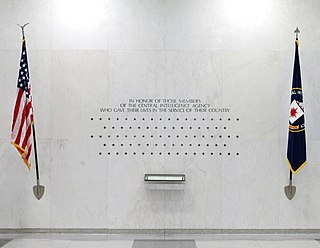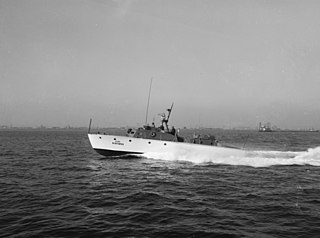Frank Gardiner Wisner served in the Office of Strategic Services in World War II, and headed the Office of Policy Coordination (OPC), a clandestine intelligence unit, from 1948 to 1950. In 1950, the OPC was placed under the Central Intelligence Agency and renamed the Directorate of Plans. The Directorate was first headed by Allen Dulles; Wisner became Deputy Director of Plans (DDP) in 1951 when Dulles was named Director of Central Intelligence. Wisner remained as DDP until September 1958, playing an important role in the early history of the CIA. In 1958 he suffered a breakdown, and retired from the Agency in 1962. He committed suicide in 1965.
The Office of Policy Coordination (OPC) was the covert operation wing of the United States Central Intelligence Agency (CIA). Created as a department of the CIA in 1948, it actually operated independently until October 1950. OPC existed until 1 August 1952, when it was merged with the Office of Special Operations (OSO) to form the Directorate of Plans (DDP).
The Directorate of Operations (DO), less formally called the Clandestine Service, is one of the smallest components of the US Central Intelligence Agency. It was known as the Directorate of Plans from 1951 to 1973; as the Directorate of Operations from 1973 to 2005; and as the National Clandestine Service (NCS) from 2005 to 2015.

The Albanian Subversion is one of the earliest and most notable failures of the Western covert paramilitary operations in the Eastern Bloc. The British SIS and the American CIA launched a joint subversive operation, using as agents Albanian expatriates. Other anti-communist Albanians and many nationalists worked as agents for Greek, Italian and Yugoslav intelligence services, some supported by the UK and U.S. secret services. A Soviet mole, and, later, other spies tipped off the missions to Moscow, which in turn relayed the information to Albania. Consequently, many of the agents were caught, put on trial, and either shot or condemned to long prison terms at hard labor.

The Central Intelligence Agency (CIA) is a civilian foreign intelligence service of the federal government of the United States, tasked with gathering, processing, and analyzing national security information from around the world, primarily through the use of human intelligence (HUMINT). As one of the principal members of the United States Intelligence Community (IC), the CIA reports to the Director of National Intelligence and is primarily focused on providing intelligence for the President and Cabinet of the United States.
Thomas Hercules Karamessines was the Deputy Director for Plans of the United States Central Intelligence Agency from July 31, 1967 until February 27, 1973. Karamessines was actively involved in the Agency's Project FUBELT to undermine the government of Chilean president Salvador Allende.
A clandestine operation is an intelligence or military operation carried out in such a way that the operation goes unnoticed by the general population or specific enemy forces.
Executive oversight of United States covert operations has been carried out by a series of sub-committees of the National Security Council (NSC).
A clandestine cell system is a method for organizing a group of people such as resistance fighters, sleeper agents, or terrorists so that such people can more effectively resist penetration by an opposing organization.
National governments deal in both intelligence and military special operations functions that either should be completely secret, or simply cannot be linked to the sponsor. It is a continuing and unsolved question for governments whether clandestine intelligence collection and covert action should be under the same agency. The arguments for doing so include having centralized functions for monitoring covert action and clandestine HUMINT and making sure they do not conflict, as well as avoiding duplication in common services such as cover identity support, counterespionage, and secret communications. The arguments against doing so suggest that the management of the two activities takes a quite different mindset and skills, in part because clandestine collection almost always is on a slower timeline than covert action.

The military history of Australia during the Korean War was very eventful. Japan's defeat in World War II heralded the end to 35 years of Japanese occupation of the Korean Peninsula. The surrender of Japan to the Allied forces on 2 September 1945 led to the peninsula being subsequently divided into North and South Koreas, with the North being occupied by troops from the Soviet Union, and the South, below the 38th Parallel, being occupied by troops from the United States.
At various times, under its own authority or in accordance with directives from the President of the United States or the National Security Council staff, the Central Intelligence Agency has attempted to influence domestic and international public opinion.
This is a list of activities carried out by the U.S. Central Intelligence Agency in China.

The evacuation of Karafuto (Sakhalin) and the Kuriles refers to the events that took place during the Pacific theater of World War II as the Japanese population left these areas, to August 1945 in the northwest of the main islands of Japan.

Allegations that the United States military used biological weapons in the Korean War (1950–53) were raised by the governments of People's Republic of China, the Soviet Union and North Korea. The claims were first raised in 1951. The story was covered by the worldwide press and led to a highly publicized international investigation in 1952. US Secretary of State Dean Acheson and other US and allied government officials denounced the allegations as a hoax. Subsequent scholars are split about the truth of the claims.

Initially established as the Air Force (USAF) Security Group in June, 1948, the USAF Security Service (USAFSS) was activated as a major command on Oct 20, 1948

The United States Central Intelligence Agency (CIA) was created on July 26, when Harry S. Truman signed the National Security Act of 1947 into law. A major impetus that has been cited over the years for the creation of the CIA was the unforeseen attack on Pearl Harbor, but whatever Pearl Harbor's role, in the twilight of World War II it was considered clear in government circles that there was a need for a group to coordinate government intelligence efforts, and the Federal Bureau of Investigation (FBI), the State Department, and the War Department, and even the Post Office were all jockeying for that new power.

The 22nd Crash Rescue Boat Squadron was a U.S. Air Force combat search and rescue unit formed during the Korean War. While its original task was ocean rescue of downed pilots, its speedy and well-armed boats soon became prime vehicles for inserting spies, espionage agents, and sabotage parties into enemy territory for the 6004th Air Intelligence Service Squadron. Despite the hazards of both their overt and covert missions, the airmen of the 22nd CRBS never lost a boat during their clandestine operations in the war.
The Korean War Covert Missions were covert missions performed to assist in ending The Korean War, which took place from 1950-1953.







